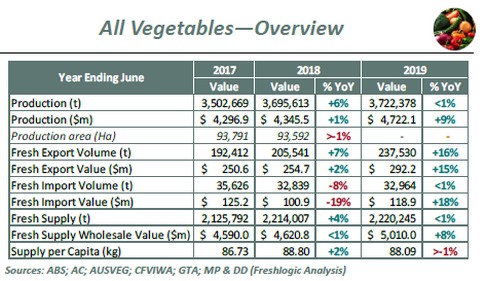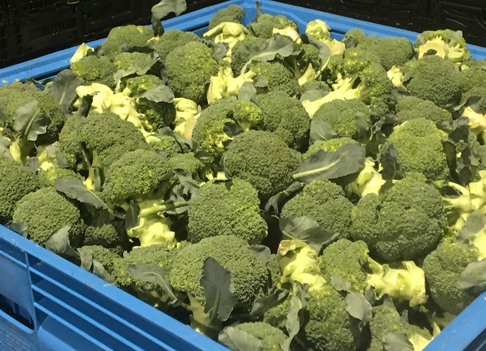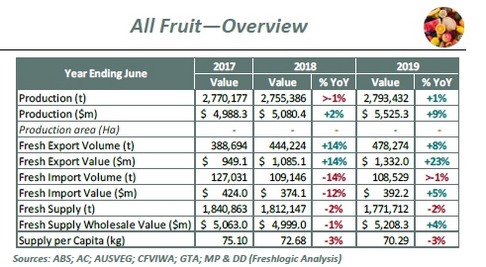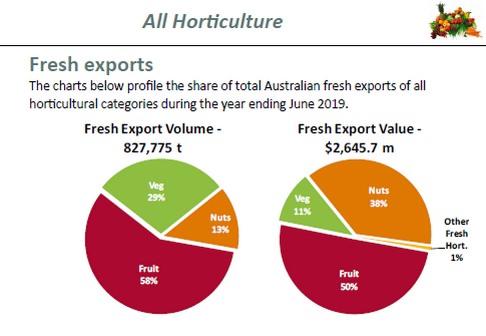The latest edition of Hort Innovation's Australian Horticulture Statistics Handbook has shown that the sector has recorded its highest production value to date, in 2018/19.
The Handbook features data on more than 70 horticultural products including fruit and vegetables, but also nuts, nursery, turf and cut flowers up to the end of June 2019.
It reports that the sector has experienced seven years of consecutive growth, with the new data showing industry growth by 8.4 per cent or a $1.1billion annual increase to reach a total value of $14.4billion. The average compound annual growth rate over the last five years has been 5.6 per cent or a total of 31 per cent.
The entire fruit category had an increase in production of just one per cent, but the value increased by nine per cent to $5.5billion. It was a similar story in the vegetable category, with a volume increase of less than one per cent, but a jump in value by nine per cent to $4.7billion.
Volume-wise, potatoes were the highest weighing horticulture commodity with 1,380,385 tonnes, followed by the entire citrus category (744,374 tonnes), in which oranges made up 528,095 tonnes. The next highest was tomatoes with 469,199 tonnes, carrots with 332,598 tonnes, and apples with 310,875 tonnes.

Graphic courtesy: Australian Horticulture Statistics Handbook 2018/19
Avocados had an 11 per cent increase in volume to 85,546 tonnes, but a fall in the value of 18 per cent to $444million. While bananas, which are only supplied to the domestic market, had a four per cent decline in production, but a jump of 25 per cent in value to $604million.
Cherries had a substantial jump in both volume and value, up 29 per cent in volume to 20,148 tonnes valued at $189.3million - a 27 per cent increase. However, Kiwifruit had a 26 per cent drop in volume (to 7,134 tonnes) and a 28 per cent decrease in value ($19million). Lychees had a four per cent increase in volume, but a 43 per cent jump in value. Passionfruit also gained value, with a 23 per cent increase to $20.6million despite a less than one per cent decrease in volume.
The value and volume of raspberries and blackberries put them as the highest growing fruit over the five years leading up to 2018/19, with total value increasing one-and-a-half times since 2013/14 and volume nearly tripling.

The value of the vegetable category increased by nearly nine per cent to reach a value of $4.7 billion in 2018/19, with potatoes were the most valuable vegetable product at $752.6 million. The value of bean production increased by 45 per cent year on year – the highest increase of a vegetable product in value terms.
The volume of sweet potatoes grown increased an average of 12 per cent per year for the last five years, the highest growth rate of all vegetables. The total volume produced in 2018/19 is almost double that of 2013/14 levels.
In 2018/19 asparagus had an increase of 35 per cent to 10,237 tonnes and a 42 per cent jump to $86.6million. Celery fell by six per cent in terms of volumes produced to 61,245 tonnes but had a significant 24 per cent increase in value to $74.9million. While still a small industry in Australia, garlic production increased significantly, a jump of 33 per cent in volume (2,812 tonnes) and 26 per cent in value ($19.3million). Leafy Salad Vegetable production was also up 19 per cent to 67,039 tonnes with a value of $396.3million.

Graphic courtesy: Australian Horticulture Statistics Handbook 2018/19
In trade, the fruit category had an 8 per cent in export volumes to 478,000 tonnes, and a 23 per cent jump in value to $1.3billion. Imports were down by less than one per cent. While in vegetables there were higher increases in exports, with the volume up by 16 per cent to 237,530 and an increase of 15 per cent in value to $292million.
The 2018/19 value of table grapes exported increased by 44.5 per cent annually to reach a record value exceeding $500 million, now larger than the value of all citrus combined. Almonds were the highest-valued horticulture product overall, achieving a record export value of $675 million.
The export volumes of avocados increased by 79 per cent and jumped by 69 per cent in value to $19.7million. The summerfruit category also increased export numbers with a 30 per cent jump in volume to 23,045 tonnes and a value increase by 37 per cent to $89million. These increases were spread across all varieties; apricots, peaches, nectarines and plums.

Graphic courtesy: Australian Horticulture Statistics Handbook 2018/19
Export volumes of carrots remained steady, with a slight increase of 2 per cent in both volume and value; 110,213 tonnes worth $96.6million dollars. Onions were up by 56 per cent in export volume, to 47,490 and an 81 per cent jump in value to 39.2million.
Hort Innovation’s Head of Data and Insights, Adam Briggs, said the Handbook provided new metrics which reported information about retail and foodservice distribution for fruit and vegetable products, and the accessibility of the Handbook has also been improved.
“The new interface allows users to dynamically select products ‘on-demand’ and perform a greater range of time series analysis on the data which now dates back seven years to 2012/13,” he said. “These additional features mean that our stakeholders have more horticulture statistics available at their fingertips so they can remain informed and make the best decision for the success of their businesses. Hort Innovation is excited to launch this new iteration and will continue to develop the data.”

To access Hort Innovation’s Australian Horticulture Statistics Handbook 2018-19, visit: www.horticulture.com.au/hortstats.
